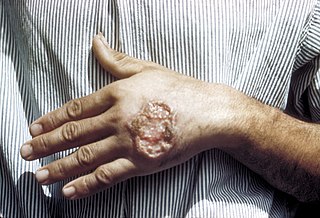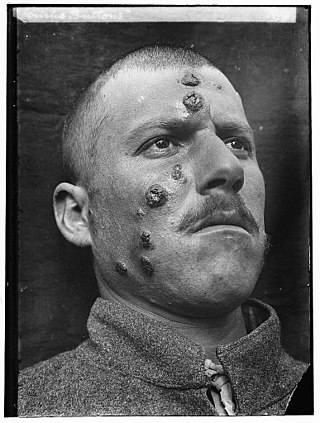Related Research Articles

Leishmaniasis is a wide array of clinical manifestations caused by protozoal parasites of the Trypanosomatida genus Leishmania. It is generally spread through the bite of phlebotomine sandflies, Phlebotomus and Lutzomyia, and occurs most frequently in the tropics and sub-tropics of Africa, Asia, the Americas, and southern Europe. The disease can present in three main ways: cutaneous, mucocutaneous, or visceral. The cutaneous form presents with skin ulcers, while the mucocutaneous form presents with ulcers of the skin, mouth, and nose. The visceral form starts with skin ulcers and later presents with fever, low red blood cell count, and enlarged spleen and liver.

Lichen planus (LP) is a chronic inflammatory and autoimmune disease that affects the skin, nails, hair, and mucous membranes. It is not an actual lichen, but is named for its appearance. It is characterized by polygonal, flat-topped, violaceous papules and plaques with overlying, reticulated, fine white scale, commonly affecting dorsal hands, flexural wrists and forearms, trunk, anterior lower legs and oral mucosa. The hue may be gray-brown in people with darker skin. Although there is a broad clinical range of LP manifestations, the skin and oral cavity remain as the major sites of involvement. The cause is unknown, but it is thought to be the result of an autoimmune process with an unknown initial trigger. There is no cure, but many different medications and procedures have been used in efforts to control the symptoms.

Tuberculosis verrucosa cutis is a rash of small, red papules and nodules in the skin that may appear two to four weeks after inoculation by Mycobacterium tuberculosis in a previously infected and immunocompetent individual.

Cutaneous leishmaniasis is the most common form of leishmaniasis affecting humans. It is a skin infection caused by a single-celled parasite that is transmitted by the bite of a phlebotomine sand fly. There are about thirty species of Leishmania that may cause cutaneous leishmaniasis.

Trichobacteriosis axillaris is a superficial bacterial colonization of the hair shafts in sweat gland–bearing areas, such as the armpits and the groin. It is a trivial disease of worldwide occurrence that is believed to be caused by the genus Corynebacteria.

A blue nevus is a type of coloured mole, typically a single well-defined blue-black bump.

Lipodermatosclerosis is a skin and connective tissue disease. It is a form of lower extremity panniculitis, an inflammation of the layer of fat under the epidermis.
Tuberculosis cutis orificialis, also known as acute tuberculous ulcer or orificial tuberculosis,) is a form of cutaneous tuberculosis that occurs at the mucocutaneous borders of the nose, mouth, anus, urinary meatus, and vagina, and on the mucous membrane of the mouth or tongue.
Paraneoplastic acrokeratosis, or Bazex syndrome is a cutaneous condition characterized by psoriasiform changes of hands, feet, ears, and nose, with involvement of the nails and periungual tissues being characteristic and indistinguishable from psoriatic nails. The condition is associated with carcinomas of the upper aerodigestive tract.
Blastomycosis-like pyoderma is a cutaneous condition characterized by large verrucous plaques with elevated borders and multiple pustules.
Cutaneous actinomycosis is a chronic disease that affects the deep subcutaneous tissue of the skin. Caused by an anaerobic, Gram-positive, filamentous type of bacteria in the genus Actinomyces, invasion of the soft tissue leads to the formation of abnormal channels leading to the skin surface that discharge pale yellow sulfur granules.

Cutaneous lymphoid hyperplasia refers to a groups of benign cutaneous disorders characterized by collections of lymphocytes, macrophages, and dendritic cells in the skin. Conditions included in this groups are:
Wende–Bauckus syndrome is a cutaneous condition characterized by tiny white macules on the trunk with confluence within flexures.

A myxoid cyst is a cutaneous condition often characterized by nail plate depression and grooves.
Tulip fingers are a cutaneous condition, a combined allergic and irritant contact dermatitis caused by contact with tulip bulbs.

Kraurosis vulvae or vulvar lichen sclerosus (VLS) is a cutaneous condition characterized by atrophy and shrinkage of the skin of the vagina and vulva often accompanied by a chronic inflammatory reaction in the deeper tissues.

Laryngo-onycho-cutaneous syndrome is a rare epithelial disorder inherited in an autosomal recessive fashion. It is characterized by abnormalities in the larynx, nails, and skin ("cutaneous"). The disorder is only found in Punjabi Muslims and only a few cases have been reported.
A syphilid is any of the cutaneous and mucous membrane lesions characteristic of secondary and tertiary syphilis.
Pseudomonal pyoderma is a cutaneous condition, a superficial infection of the skin with P. aeruginosa. The skin can have a 'mousy' odor. It presents typically on the feet with macerated 'moth-eaten' appearance, green-blue purulence, and eroded borders.

Sarcoidosis, an inflammatory disease, involves the skin in about 25% of patients. The most common lesions are erythema nodosum, plaques, maculopapular eruptions, subcutaneous nodules, and lupus pernio. Treatment is not required, since the lesions usually resolve spontaneously in two to four weeks. Although it may be disfiguring, cutaneous sarcoidosis rarely causes major problems.
References
- ↑ Rapini, Ronald P.; Bolognia, Jean L.; Jorizzo, Joseph L. (2007). Dermatology: 2-Volume Set. St. Louis: Mosby. ISBN 978-1-4160-2999-1.
- ↑ "Answers - the Most Trusted Place for Answering Life's Questions". Answers.com .